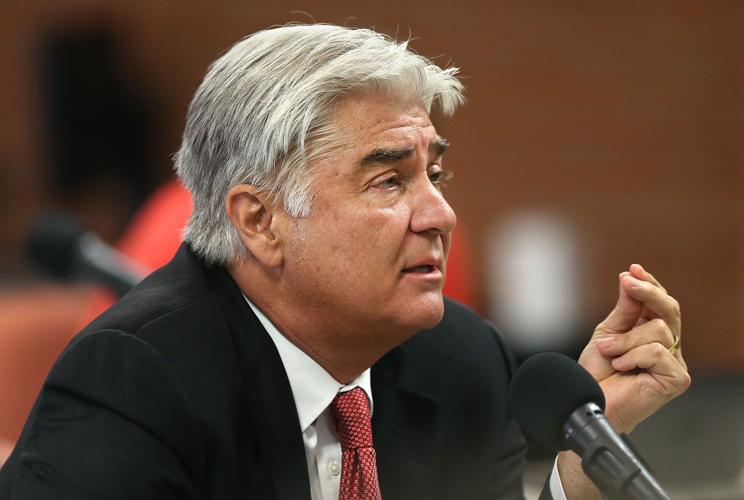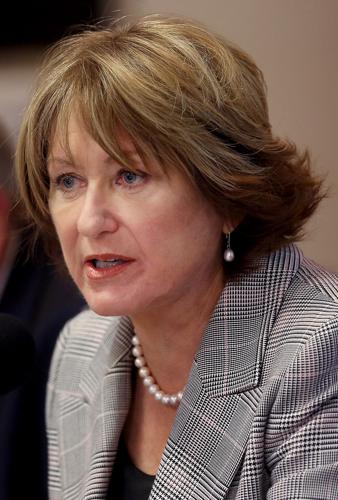The University of Arizona’s vice president of health sciences may be under scrutiny, but he was heavily praised during a special meeting in Tucson Friday afternoon.
During the public comment period of a four-hour Arizona Board of Regents Health Affairs Committee meeting, 14 people lauded Dr. Joe G.N. “Skip” Garcia for his leadership, among them Pima County Health Department Director Dr. Francisco Garcia and Pima County Supervisor Richard Elías.
Garcia, who earns $870,00 per year, has come under scrutiny for his leadership, and for his travel expenses. Public attention on him began after six key leaders at the UA College of Medicine Phoenix left earlier this year, including its dean, Dr. Stuart Flynn.
The Tucson regents meeting and another one held in Phoenix Aug. 5 were convened after the Arizona Medical Association took a vote of “no confidence” in the UA’s health sciences leadership. The association asked the regents to conduct an independent investigation.
It’s unclear how the Arizona Board of Regents, which is the governing body of the state’s public university system, will proceed after the Tucson hearing. Board of Regents President Eileen Klein opened the meeting by saying that in recent days there have been questions about use of public money by UA health sciences and that action outside of the special meeting may be needed.
“Superstar”
Garcia’s long line of supporters, some of them UA Health Science employees, called him “transformational” and a “superstar.” Some said that over the next decade he could help make Banner-University Medical Center Tucson one of the best hospitals in the nation.
UA cardiothoracic surgeon Dr. Zain Khalpey told the regents that in 2013 his department was disintegrating and he was ready to leave. But Garcia put words into action, he said, and the UA Health Network’s merger with Phoenix-based Banner Health, which occurred last year under Garcia’s watch, has been a stabilizing force. Banner was the surviving entity in that merger.
“I want to stay here and grow,” he said.
The Arizona Medical Association’s House of Delegates in June took a vote of “no confidence” in the governance of the UA’s two medical schools, which ultimately falls under the leadership of Garcia and UA President Ann Weaver Hart.
Garcia, who reports directly to Hart, oversees all of the UA’s health colleges — the UA College of Medicine-Tucson, the UA College of Medicine-Phoenix, the UA College of Pharmacy, the UA College of Nursing, and the UA Mel and Enid Zuckerman College of Public Health.
The Arizona Medical Association also wants the Arizona Board of Regents to oversee an independent investigation into “any U of A organizational impediments or policies that contributed to the departures of the well-respected and quality team that was in place.”
Garcia, who earns a salary of $870,000, last week was the subject of an Arizona Republic article that focused on his travel expenses, including a chauffeured car that costs $475 or more for trips between Tucson and Phoenix.
Many of Garcia’s supporters spoke against the news article, though they did not question its accuracy. They said it was harmful to the pathway to success that Garcia began when he came to the UA in 2013. They say that Garcia, buoyed by the Banner merger and a Banner academic affiliation with the UA, is helping to take the UA and its hospitals to world-class excellence.
Several applauded when Regent Rick Myers said that focusing on Garcia’s travel costs is “irrelevant,” given all the positive things happening within UA Health Sciences.
“I don’t know if we are not telling the story right or if the media is not listening,” Myers said.
NIH grant
Regent Ron Shoopman said that when massive change occurs in an institution, people either get on board with it and move with the change, or they judge.
Shoopman and others spoke of a need for better communication about UA Health Sciences successes, among them a recently announced $43.3 million National Institutes of Health (NIH) award over five years that’s part of the Precision Medicine Initiative that President Obama introduced in his 2015 State of the Union address.
The White House describes the initiative as “a bold new research effort to revolutionize how we improve health and treat disease.”
Other major grants were also awarded in the past year under Garcia’s leadership and are expected to boost the UA’s reputation as a research institution, he and others said.
In addition, both UA medical schools had a record number of applicants for the current academic year — 6,458 to the UA College of Medicine Tucson and 5,358 to the UA College of Medicine Phoenix. The Tucson medical school made 200 offers of admission, and the Phoenix school made 153.
The UA’s medical schools in Tucson and Phoenix are not two branches of one school. Rather, they are separately accredited institutions and at the moment are the sole medical schools for training allopathic physicians in Arizona.
Though they are two separate schools, they are both under the same governance, led by Hart and Garcia.
And therein lies the rub for some critics who say that the Garcia-Hart combination has been too self-serving and not responsive to the needs of leaders at the Phoenix medical school.
Accreditation woes
Flynn, who had been in his job since 2008, recently left for a position in Texas. After he announced his departure, five other key leaders in the Phoenix medical school said they were leaving, too.
Four followed Flynn to Texas, where he’ll be founding dean of a medical school jointly operated by Texas Christian University and the University of North Texas Health Science Center. One went to a bigger job at Case Western Reserve University in Cleveland.
Those departures occurred as the 9-year-old UA College of Medicine Phoenix is in the midst of trying to get full accreditation.
Last year, the Liaison Committee on Medical Education wrote a letter to the school saying changes would be needed in order to secure full accreditation.
The accrediting body expressed concern about the recent academic affiliation between Banner Health and the UA.
The Phoenix medical school has since been granted provisional accreditation this year, which puts it on pace for full accreditation in 2017, UA health science officials say.
It was the leadership void and its potential effect on the accreditation that led to the medical association’s “no-confidence” action.
The 4,000-member, 120-year-old association’s action was unprecedented, executive vice president Chic Older said in an interview last week. In addition to the no-confidence vote, the association has asked the Arizona Board of Regents to take “corrective action,” based on an investigation, “to ensure long-term excellence in medical education at the U of A College of Medicine Phoenix and Tucson.”
Hart said she’ll be doing a “climate survey” of the work environment at the UA’s health colleges through a third party, and that she’ll also have an outside investigator do exit interviews with all the Phoenix leaders who left.
But Older has said the association wants the investigation at the behest of the regents, not the UA.
“Huge” loss
The loss of Flynn was “huge” for the fledgling Phoenix medical school, which sits amid a growing biomedical campus in the city’s downtown core, said Cary Pfeffer, a Phoenix resident, author and owner of a consulting firm who sat on a community advisory board to the Phoenix medical school for several years.
Pfeffer said he joined the board because he wanted to have an active role in an important educational institution.
“I didn’t go to the UA; I don’t have kids interested in becoming doctors. But the more I learned about the school, the more impressed I was. Especially knowing where we are with our need for doctors and medical professionals,” Pfeffer said. “It is an easy place to support.”
The advisory board has not met since Flynn’s departure, he said.
“I think Stuart did a terrific job,” Pfeffer said. “But he also assembled a great team to share his level of enthusiasm in all segments of the organization.
“When you have strong, inspiring, selfless leaders, people generally want to stay with them. I don’t think President Hart or Dr. Garcia have provided that kind of leadership.”
Garcia has said that the departure of several senior leaders is not unusual in academic medicine.
“It doesn’t happen when the top leadership is supportive and leads selflessly,” countered Pfeffer. “Individual members on the Board of Regents have known about this for years, how these two do not lead.”
Specifically, Pfeffer said, Garcia was not providing enough support to the senior leadership at the Phoenix medical school.
“It strikes me as an imperialistic sort of governance from afar,” he said.
Some of the adversity about the College of Medicine Phoenix appears to be related to a longstanding “Phoenix versus Tucson” mentality that isn’t helping anyone, Myers said.
Garcia said the schools have distinct missions and characteristics. It’s in the interest of the UA to have both medical schools succeed — never one over the other, he said.
New medical school
In one year, the UA will not be the only medical school in the state training allopathic (M.D.) physicians.
A third allopathic medical school will be opening a campus in Arizona. The Mayo Clinic, which is based in Minnesota, will open its medical school in Scottsdale in the summer of 2017 with a class of 50 students, spokesman Jim McVeigh said.
Two other private medical schools in Arizona — A.T. Still University in Mesa and Midwestern University in Glendale — both offer D.O. degrees in osteopathic medicine.
A key to alleviating a current and projected future doctor shortage is for communities to have medical schools and residency positions. That’s why medical schools are a premium for major cities.
In a ranking of best to worst rates, Arizona ranks 36th in active primary physicians, the Association of American Medical Colleges says.
The state has 79.2 active primary care doctors per 100,000 people. The highest-ranked state, Massachusetts, has 131.9 active primary physicians per 100,000 people, the association’s most recent numbers show.







